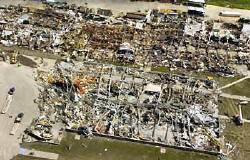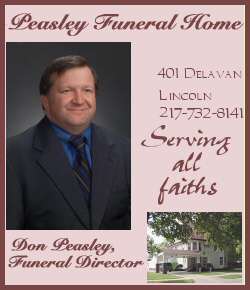|
About three hours later, a shower
developed in western Woodford County on a boundary that came from
the large supercell. Within 20 minutes, this storm was showing signs
of becoming severe. A severe thunderstorm warning was issued by the
National Weather Service in Lincoln at 2:29 p.m.

Parsons Company plant before storm damage
At that time, the NOAA Weather Radio
alarm went off in the business office of the Parsons Company manufacturing
plant. The emergency response team leader of the facility was
immediately notified. A few moments later he walked outside and
noticed a rotating wall cloud with a developing funnel cloud. He
radioed back to the office to institute the company's severe weather
plan. Someone from the accounting department went on the plant's PA
system and announced that everyone should go to their designated
storm shelter and that it was not a drill -- this was a real event.
Three months earlier the plant had
conducted one of its semiannual tornado drills successfully.
Everyone got to the shelters in less than four minutes.

Parsons plant during the storm
Similar to the drill, everyone
calmly went to their designated shelters -- all 150 people in the
three buildings of the plant. While they were doing this, the
National Weather Service in Lincoln issued a tornado warning at 2:34
p.m. At the same time, a county spotter reported a tornado one mile
northeast of Metamora -- about four miles west-northwest of the
facility.
The leader of the emergency response
team had enough time to check on all three shelters to make sure
that everyone was there. He took one final look and noticed that the
tornado was heading right for the facility and was less than a mile
away. He ran to the closest tornado shelter about 1½ minutes before
the tornado destroyed the plant at 2:41 p.m.

When the tornado moved out of the
area, the employees emerged to see the destruction. The entire
business was heavily damaged, beams were twisted, parts and
machinery were strewn everywhere, and more than 60 autos were
launched into the buildings. The most startling thing was that no
one at the plant was killed or injured. All 150 people were
accounted for.

Parsons plant after the storm
[to top of second column in this article] |
 The company owner had witnessed
tornado damage at the business he was working for 30 years earlier.
Shortly afterward, when he built his own business, he was concerned
that a tornado could strike again. He did not want to take any
chances, so he built the restrooms to also be tornado shelters, with
reinforced concrete walls and 8-inch thick concrete ceilings. These
"safe rooms" made the difference between life and death for 150
people who were caught in the middle of an F4 tornado with winds
estimated to be up to 240 mph.

This case was proof that having a
plan, practicing the plan and implementing the plan saved lives. It
also shows that the company saved lives and gave employees extra
time to go to their shelters by responding to a severe thunderstorm
warning.
Overall, the tornado was 9.6 miles
long, one-fourth mile wide and had a lifespan of 21 minutes. It also
affected half a dozen farmsteads, with no fatalities and three minor
injuries.
This story will be featured on the
program "Storm Stories" on The Weather Channel at 7 p.m. March 9.

Parsons Company has received
national recognition for its lifesaving efforts. The company has
been awarded by the Illinois Emergency Management Agency and has
been nominated for the Mark Trail Award, given annually to
individuals or groups by NOAA's National Weather Service for the use
of NOAA Weather Radio in a lifesaving effort.
[Provided by Chris Miller, warning coordination
meteorologist, National Weather Service-Lincoln]
Previous articles
 |

